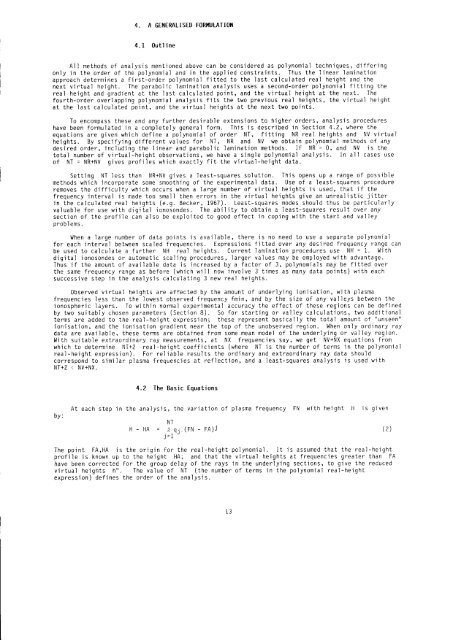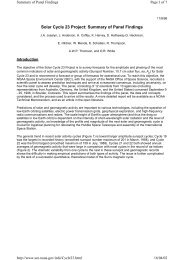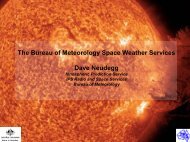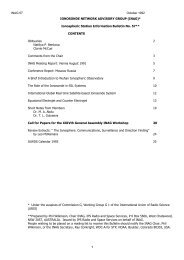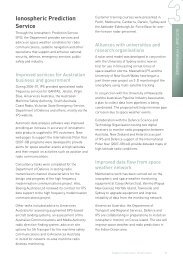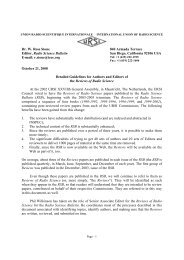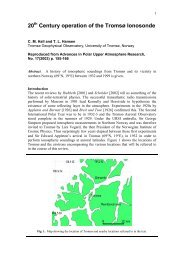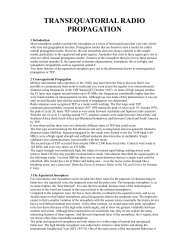UAG-93: Chapters 1 to 5 - URSI
UAG-93: Chapters 1 to 5 - URSI
UAG-93: Chapters 1 to 5 - URSI
You also want an ePaper? Increase the reach of your titles
YUMPU automatically turns print PDFs into web optimized ePapers that Google loves.
4. A GEilERALISED FORruLATIOI{<br />
4.1 0utl ine<br />
All rnethods of analysis mentioned above can be considered as polynomial techniques, differing<br />
only in the order of the polynomial and in the applied constrajnts. Thus the linear lamination<br />
approach determines a first-order polynomial fitted <strong>to</strong> the last calculated real height and the<br />
next virtual height. The parabolic lamination ana)ysis uses a second-order polynomial fitting the<br />
real helght and gradient at the last calculated point, and the virtual height at the next. The<br />
fourth-order overlapping polynomial analysis fits the two previous real heights, the virtual height<br />
at the last calculated point, and the virtual heights at the next two points.<br />
To encompass these and any further desirable extensions <strong>to</strong> higher orders, analysis procedures<br />
have been formulated in a completely general form. This is described in Section 4.2, where the<br />
equations are given which defjne a polynomial of order NT, fitting NR real heights and NV virtual<br />
heights. By specifying different values for NT, NR and NV we obtain polynomial methods of any<br />
desired order, including the linear and parabolic lamination methods. 1f NR = 0, and NV is the<br />
<strong>to</strong>tal number of virtual-height observations, we have a single polynomial analysis. In all cases use<br />
of NT = NR+NV gives profiles which exactly fit the virtual-height data.<br />
Setting NT less than NR+NV gives a least-square solution. This opens up a range of possible<br />
methods which incorporate some smoothing of the experimental data. Use of a least-squares procedure<br />
removes the difficulty which occurs when a large number of virtual heights is used, that if the<br />
frequency interval is made <strong>to</strong>o small then errors in the virtual heights give an unnealistic iitter<br />
in the calculated real heights (e.9. Becker, 1967). Least-squares mode should thus be part.icularly<br />
valuable for use with digital ionosondes. The ability <strong>to</strong> obtain a least-squares result over any<br />
section of the profile can also be exploited <strong>to</strong> good effect in coping with the start and valley<br />
probl ems.<br />
l,lhen a large number of data points is available, there is no need <strong>to</strong> use a separate polynomial<br />
for each interval between scaled frequencies. Expressions fitted over any desjred frequency range can<br />
be used <strong>to</strong> calculate a further NH real heights. Current lamination procedures use NH = 1. l,lith<br />
digital ionosondes or au<strong>to</strong>matic scaling procedures, larger values may be employed with advantage.<br />
Thus if the amount of available data is increased by a fac<strong>to</strong>r of 3, polynomials may be fitted over<br />
the same frequency range as before (which will now involve 3 t'imes as many data points) with each<br />
successive step in the analysis calculating 3 new real heights.<br />
0bserved virtual heights are affected by the amount of underlying ionisation, with plasma<br />
frequencies less than the.lowest observed frequency fmin, and by the size of any valleys between the<br />
ionospheric layers. To within normal experimental accuracy the effect of these regions can be defined<br />
by two suitably chosen parameters (Section B). So for start.ing or va1ley calculations, two additional<br />
terms are added <strong>to</strong> the real-height expression; these represent basically the lotal amount of "unseen"<br />
ionisation, and the ionisation gradient near the <strong>to</strong>p of the unobserved region. When only ordinary ray<br />
data are available, these terms are obtained from some mean model of the underlying or valley region.<br />
Wjth suitable extraordinar"y ray measurements, at NX frequencies say, we get NV+NX equations from<br />
which <strong>to</strong> determine NT+2 real-height coefficients (where NT is the number of terms in the polynomial<br />
real-height expression). For r"eliab.le results the ordinary and extraordinary ray data should<br />
correspond <strong>to</strong> similar plasma frequencies at reflection, and a least-squares analysis is used with<br />
NT+2 < NV+NX.<br />
4.2 The Basic Equations<br />
by:<br />
At each step in the analysis, the vaniat.ion of plasma frequency FN with height H is given<br />
NT<br />
H - H A = : q 1 ( F N<br />
J-r<br />
FA )i \2)<br />
The point FA,HA is the origin for the real-height polynornial. It is assumed that the real-height<br />
profile is known up <strong>to</strong> the height HA; and that the vjrtual heights at frequencies greater than FA<br />
have been cornected for the group delay of the rays in the underly'ing sections, <strong>to</strong> give the reduced<br />
virtual heights h". The value of NT (the number of terms in the polynomial real-height<br />
exoression) defines the order of the analysis.<br />
L3


